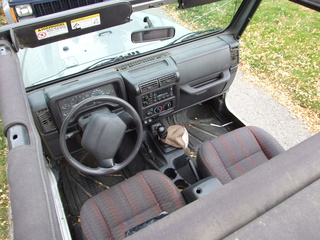More Jeep stuff

The Road Chose Me Volume 2 OUT NOW!!
The Road Chose Me Volume 2: Three years and 54,000 miles around Africa
The 16th marked three months on the road for me, and I’ve done spot on 15,000 kms. At this rate I’ll cover 60,000 kms in twelve months, which I’ve been thinking is more likely what the trip will wind up being. That’s nothing scientific, just a gut feeling I have. I’m covering a lot of ground because I’ve been zig-zagging and detouring a lot to make sure I see and do everything I want – which really is the whole point.
I seem to be getting more and more efficient with my camping, cooking, directions, activities and resupplying so everything is still getting easier day to day.
I just did another oil change and tire rotation, which gave me another chance to crawl all over the Jeep and have a good look. I noticed a few things:
- My ‘new’ tires are wearing much faster than I had hoped. At this rate I don’t think they’ll make the whole trip, but we’ll see what happens. I picked up another flat a couple of weeks back bringing the count to two.
- The pinion seal on the front diff is leaking again… it really shouldn’t be doing that, but it’s never going to amount to much so I’m going to leave it.
- The passenger foot well is soaking wet sometimes which I think is either the heater core leaking, water getting in between the windshield and hood or a missing drain plug in the floor. I still haven’t figured out exactly when it happens so I need to keep thinking about it.
- Even after 10,000 kms the engine oil was still pretty good, I think it really likes the highway driving.
The Jeep has been running brilliantly, with only one ‘problem’ for the whole trip. I think it was more operator error, but I’ll let you decide 
The plastic drain plug on the bottom of the radiator had been leaking a few drops here and there since I flushed the whole thing before leaving. When I was in Skagway, Alaska I noticed it was more than the usual few drops, so I tried to tighten it. Of course I went for too much, and the plug broke off in my hand. I ummed and arred for a while before finally deciding to pull the whole radiator out – I didn’t want any little plastic fragments floating around in there waiting to hit the water pump blades or puncture a hose.
The whole deal took about an hour and a half, and it’s nice to know it’s all fixed properly.
-Dan





Dan,
The passenger foot well is definitely the heater core. It happens all the time in TJs. I don’t remember the exact fix, but I’m sure a very quick search on jeepforum.com will show the answer.
And good call with replacing the radiator. They are also pretty common to go bad. They normally go bad around 75k – 100k miles. If it happens again, get a double core aluminum one
Andy, Thanks for the info. I’m not loosing any coolant, which I think would be happening if the radiator core was leaking. Is that correct? Thanks.
Came across the blog on Jeepforum.com and have been browsing it from the beginning this morning.
Wouldn’t worry about the passenger floor getting wet. Water gets in in two locations on that side of the jeep. The first is there is an air intake for the vents under the front cowel. If there is a bit of a gap between the intake and the cowel water will get in.
The other spot is where the blower fan is located which is right behind the battery. Less likely there unless heavy water (i.e. a hose). Found this one when I tried to flush my heater core.
On a side note I saw you have been to Nelson. My parents live about 7 miles out on the north shore and we are planning on going out next July for my cousin’s wedding. Beautiful country and the wife and I are really looking forward to going plus plan on moving out there from Ottawa.
Good luck and I can’t wait to keep reading especially how the jeep works for you!!
Hey Chris,
Thanks for the info. A while back I sealed around the air intake under the cowel and that cut down on the water by about 90%.
I think now it’s getting in around the door (there are a few gaps I can see daylight through)
My brother lives in Nelson now, beautiful countryside there. Jealous of the snowboarding right now !
All the best,
-Dan
Thanks for the Jeep post! I am kind of a Jeep buff and was secretly wondering how yours was holding up. My foot wells were filled with water too one time…I sorta kinda….did not umm…install the soft top correctly and well it rained that night (of course) and not just any rain- downpour- and the wells were filled up to my ankles. I was thankful for those drain plugs…I imagine that the same thing must have happened to someone that works at Jeep and they put that in the suggestion box at the Jeep plant. I am rambling.. nice post! Keep the Jeep posts coming!
Hey man – I’ve yet to leave the roof down in the rain, but I’m sure it will happen sooner or later. So far so good on the major mechanical items anyway. Fingers are crossed.
Leave the roof down on purpose..take lots of pictures.
HAHA – when it does happen I’ll take lots of pictures for sure
Does the wet floor smell like coolant? It’ll be pretty obvious I’m sure… If not, also check inside the front cowling. If the drain in there gets clogged, it can back up and then down your fresh air intake for cabin air vents. You can look at the vent inside the cowling, and the plastic tube where it comes out at the bottom behind the engine on the firewall.
It does not smell like coolant, and I’m not losing any either.. so I think it’s more likely what you are saying.
Thanks for the help!
Dan,
Just found your site. Very cool.
Its likely that the A/C condensate drain is plugged. Here is what Chrysler has to say:
THIS BULLETIN SUPERSEDES TECHNICAL SERVICE BULLETIN 24-007-03, DATED
AUGUST 15, 2003, WHICH SHOULD BE REMOVED FROM YOUR FILES. ALL
REVISIONS ARE HIGHLIGHTED WITH **ASTERISKS** AND INCLUDE CHANGES TO
THE TJ MODEL YEARS AND TO THE PART REQUIRED.
SUBJECT:
HVAC Drain Water Leaks Inside Vehicle And Under Passenger Side Front Carpet
OVERVIEW:
This bulletin involves installing a HVAC drain hose.
MODELS:
2002 (KJ) Liberty (Domestic Market)
2002 (KJ) Cherokee (International Market)
1997 – **2005** (TJ) Wrangler
NOTE: This bulletin applies to LHD Liberty vehicles built prior to August 10, 2001
(MDH 0810XX), and to Wrangler vehicles built prior to March 01, 2005 (MDH
0301XX).
SYMPTOM/CONDITION:
The customer may experience a wet front passenger floor or floor carpet. This condition
may occur due to water (A/C condensate) from the HVAC assembly drain tube. As A/C
condensate leaves the HVAC drain tube, it may run back along the outside of the HVAC
drain tube, enter the passenger compartment, and run under the front floor carpet on the
passenger side. This condition may occur most often while the vehicle is being driven.
DIAGNOSIS:
Inspect for the source of the water leak. Determine if the passenger side of the front floor
carpet is wet because of air conditioning condensate from the HVAC drain tube. Inspect
the HVAC assembly drain tube for the presence of a drain hose. If a HVAC assembly drain
hose is not present, and the A/C condensate from the drain tube is the cause of the water
leak, then perform the Repair Procedure.
NUMBER: 24-003-05
GROUP: Heating & A/C
DATE: February 04, 2005
PARTS REQUIRED:
Qty. Part No. Description
1 55037651AA **Hose, HVAC Drain (KJ)**
1 56000724AB **Hose, HVAC Drain (TJ)**
1 NPN Strap, Tie
REPAIR PROCEDURE:
1. Inspect the HVAC drain tube. Clean out any debris or other restrictions in the drain.
2. Install a HVAC drain hose onto the HVAC drain tube. Once assembled to the HVAC
drain tube, make sure the open end of the drain hose is facing towards the ground.
3. Install a tie strap around the drain hose to secure the hose to the HVAC drain tube.
NOTE: Inform the customer to regularly inspect the new HVAC drain hose for debris,
especially when off-road driving is performed
Hope this helps,
Jim
Thanks Jim, I’ll have a good look at it when I’m at a friend’s place shortly